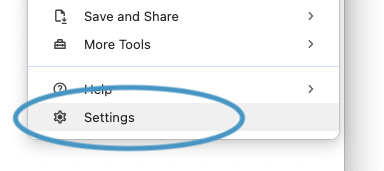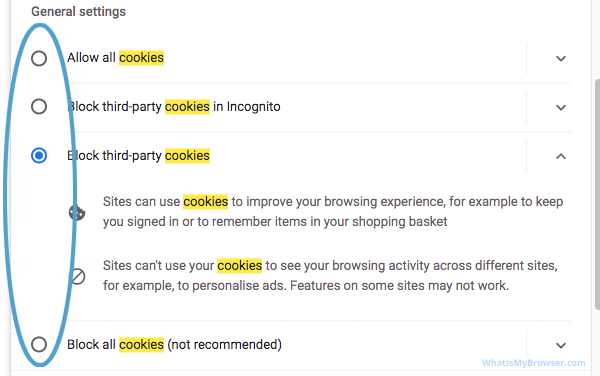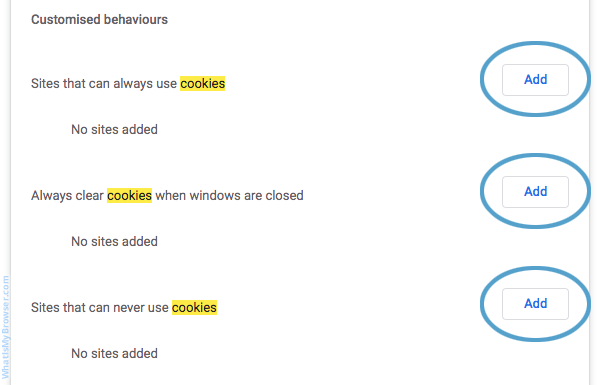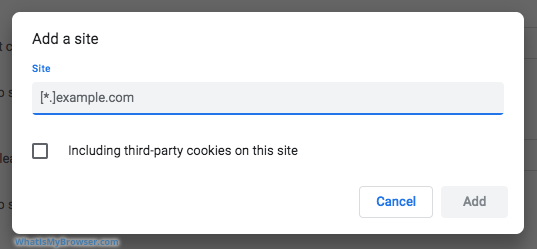Enable Cookies in Chrome
Updated at: Feb 19, 2022
This guide will step you through the process of enabling Cookies in Google Chrome.
If you don't have Chrome and would like to try it out, you can download it from the Chrome Website.
-
Select the "Settings" menu item

The Settings screen will now appear.
-
Search for the Cookies settings
The main interface for Chrome's settings will appear, with a search box at the very top. (If you only see the magnifying glass icon, either click it or drag your browser window a bit wider to make the search box appear).
Chrome has hundreds of different configuration options, so to quickly go to the Cookies settings, type the word "cookies" into the search box and Chrome will filter out options which don't match.

-
Scroll down to "Cookies and other site data" and click it
After you've typed "cookies" in the search, there will still be a number of different options listed, so you need to scroll down to the bottom of the settings screen where you will see a section named Cookies and other site data. Click on it to open the settings relating Cookies and other collected data.

-
Choose your preferred Cookies settings
You can now change your Cookies setting to what you want.
There are four main options (highlighted in the screenshot below by the blue oval) to choose from.

Allow all cookies?
Typically (especially if you are already following this guide!) you want to enable cookies in Chrome by selecting the first option - "Allow all cookies". This will allow websites to store cookies on your computer for as long as the websites want to.
This option will allow "first-party cookies" (which are cookies from the website you are actually visiting) as well as "third-party cookies" (which are cookies set by a website that's different to the one you're actually visiting - perhaps from an advertisement or a social media "Like" or "Share" button).
Block third-party cookies in Incognito
If you select this option Chrome will allow First-Party and Third-Party cookies normally, and if you are browsing in Incognito Mode, only then will it refuse Third-Party cookies (which are the kind that tend to track your behaviour online).
Block third-party cookies
This option is the sweet-spot between allowing enough Cookie functionality for most sites to work properly, but refusing the kinds of tracking cookies (Third-Party cookies) that most people have problems with.
Block all cookies?
The fourth option you have is to block all cookies. Be careful with this as it will mean that a lot of websites you visit won't work - you won't be able to log in and in some cases you might not be able to use the website at all.
Clear cookies when you exit?
Note the option at the bottom of this section: Clear cookies and site data when you close all windows. If you enable this option, then Chrome will delete all the cookies and site data each time you exit Chrome.
This will allow normal cookie functionality (eg. logging into websites with a username and password), however every time you close and reopen your web browser, you would need to log in to the website again. This setting can also help (but not necessarily eliminate) advertising companies tracking your behaviour across various browsing sessions.
If you enable this option, it may make using the internet a bit more annoying; as you will have to re-login every time you open Chrome again.
-
Allow or Block cookies on specific websites
The cookie settings that you've just changed are global - they are used for each website you visit in Chrome; For example, if you have the Block setting enabled then cookies will be blocked for every website you visit.
But this may not be exactly what you want; so Chrome also lets you choose different Cookie settings for specific websites, so if you want to generally block Cookies as you browse the web, but do want to allow them only for a handful of specific websites then it's easy to do.
To change these settings, scroll a bit further down to the Customized behaviours section, which you will see contains three main sections:
- Sites that can always use cookies
- Always clear cookies when windows are closed
- Sites that can never use cookies
Click the Add button in the section you want to configure.

After you click the Add button for the type of exception you want to create, you'll be prompted with a window asking you for the website domain to allow/clear/block.

If you enter a domain and click Add, Chrome will override the general cookies setting you've chosen for just that website. So if you have cookies blocked normally, adding a domain in the "Sites that can always use cookies" section will cause that domain to be allowed to set cookies.
If you want to specify an entire website, be sure to include the "wildcard" bit at the start - for example [*.]example.com
Allow/block only certain subdomains
You can be quite specific with the subdomains on websites that you allow to set cookies - you don't even have to allow the whole domain to set cookies, you can set it to just a specific subdomain if you want (of course whether this has any effect or not depends on how the website you're trying to allow/block works).
-
Close the settings tab
The settings you change take effect immediately, and when you're finished changing the options you can simply close the Settings tab that contained these options and resume browsing.
Congratulations, you just configured Cookies in Chrome. Click here to check if Cookies are enabled.
You may also want to take a moment to clear your cookies and history in Chrome.
